Kothari D.P., Nagrath I.J. Modern Power Systems Analysis
Подождите немного. Документ загружается.

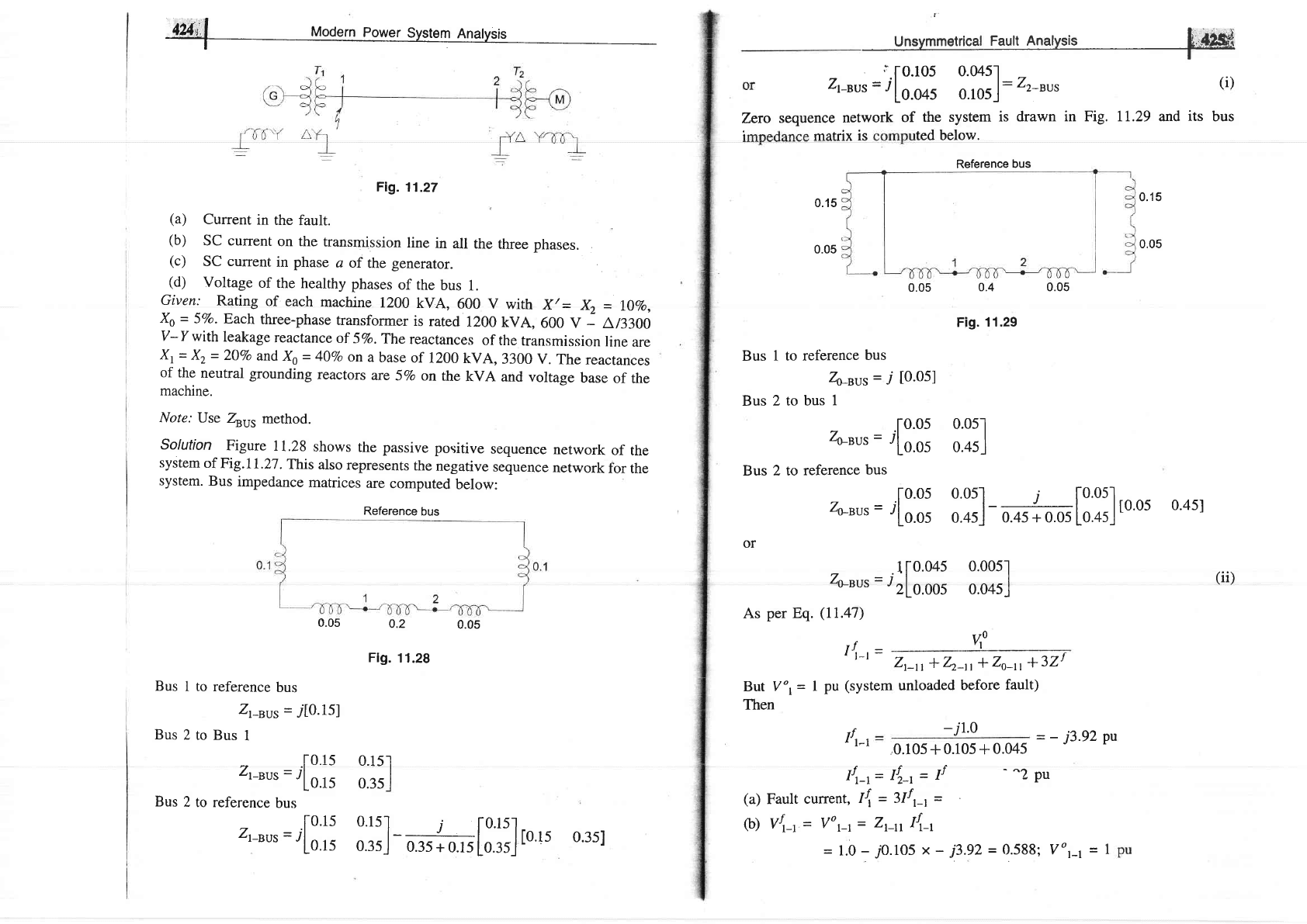
qU;l
Modern
Power
System
Anatysis
Ftg.
11.27
(a)
Current
in
the
fault.
(b)
sc current
on the
transmission
line
in all
the
three
phases.
:
(c)
SC current
in
phase
a
of
the
generator.
(d)
Voltage
of the
healrhy
phases
of the
bus
1.
Given:
Rating
of
each
machine
1200
kvA,
600
v
with
x,
=
x,
=
rTvo,
xo
=
5vo.
Each
three-phase
transformer
is
rated
rz0o
kvA,
600 v
-
nlgroo
V-Y with
leakage
reactance
of
SVo,
The
reactances
of
the
transmission
line
are
xr
=
Xz
=
20vo
and
Xo
=
40vo
on
a
base
of
1200
kVA,
3300 V.
The reactances
of
the
neutral grounding
reactors
are
5Vo
on the
kVA
and
voltage
base
of
the
machine.
Note:
Use
Z"u,
method.
Solution
Figure
11.28
shows
the passive
positive
sequence
network
of
the
system
of
Fig.l1.27.
This
also
represents
the
negative
sequence
network
for
the
system.
Bus
impedance
matrices
are
computed
below:
I
Unsymmetrlcal
Fault Analysis
f,r'4l#
-T
i
t-0.105
0.0451
zr-ws
=
rLo.o+s
o.1o5.J:
Zz-.sus
sequence
network
of
the system
is drawn
in Fig. II.29 and
its
bus
matnx ls
ted below.
(i)
Tero
0.15
0.05
0.15
0.05
0.05
0.4
Fig.
11.29
Bus
1 to ref'erence
bus
Zo-sus
=
i
[0.05]
Bus
2 to bus
I
0.05
l-0.0s
'Lo.os
.1[0.04s
0.0051
Zo-sus
=
JZIO.OO5
0.0451
0.05
Bus
I to
reference
bus
Zt_svs
=
j[0.15]
Bus
2
to Bus
I
0.2
0.05
Flg.
11.28
VO
fr_,
Zr-8r,.=
,fo'15
,t
-
rlO.tS
Bus
2
to reference
bus
zLBr,.= ,[o'15
rs
-
"/Lo.rs
o l5t
;;;l
Reference
bus
Reference
bus
l-0.05
0.051
Zo-nus
=
/Lo.os
0.451
Bus 2 to
reference
bus
7
zO-BUS
-
or
As
per
Eq.
(11.47)
II-t
=
Z;tr
*
Zz_tr
*
Zo_r,
+3Zl
unloaded
before
fault)
But V",
=
I
Pu
(sYstem
Then
-j1.0
=
-
j3.92
pu
,0.105+0.105+0.045
Ifr-t=ltr;=f
-^2Pu
(a)
Fault
current,
I\
=
3If
,-,
=
O)
Vfvr
=
Vo
r-,
=
Zt-rr lfr-t
=
1.0
-
70.105
x
-
j3.92
=
0.588; Vot;
=
|
0.051 ; l-0.051
_l l _lto.os
o.4sl
0.4s1
0.45 + 0.0s
10.451
-
(ii)
0.1s1
r l-O.tst
o35J-
**
""
Lo.rt.l
[o'ls
o'3s]
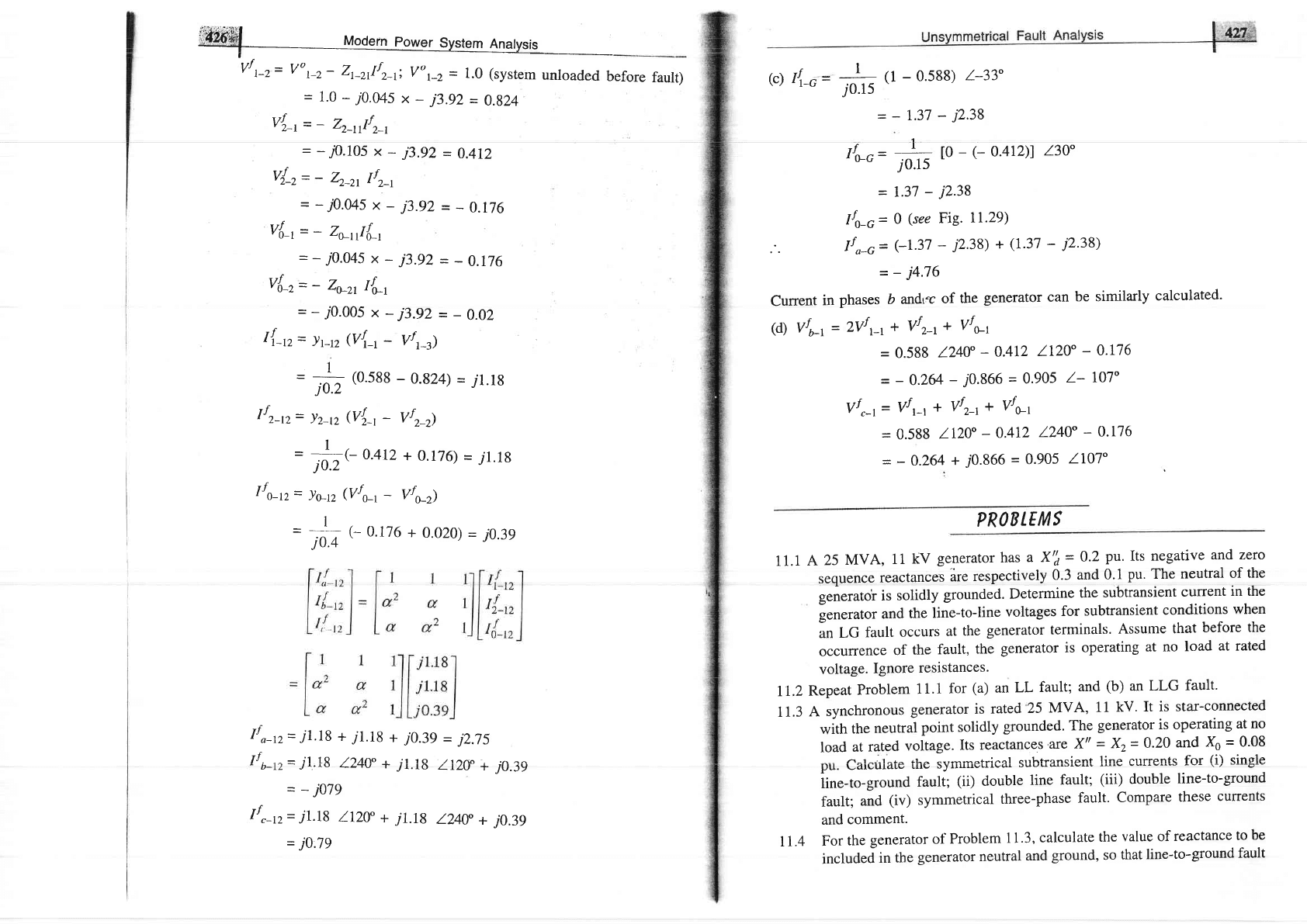
Vf
t-r=
Vor-r-
Zr-rJfr-ri
Vora
=
1.0
(system
unloaded
before
fault)
=
1.0
-
j0.M5
x
-
j3.92
=
0.g24
vtr;
=
-
zr-trfr-t
=
-70.105
x
-
j3.92
=
0.412
V{-z=
-
Zr-r,
Ifr-,
-
-
j0.045
x
-
j3.92
=
_
0.176
vfo-t
=
-
zurrlL,
-
-
j0.045
x
-
j3.92
=
_
0.176
vt-z=
-
Zuy
IL,
=
-
7O.005
x
-
j3.92
=
-
0.02
I{-rz=
yvrz
(VI_r
-
Vfr_r)
=
-
1-
(0.588
-
0.824)=
jl.r8
j0.2
Ifr-rr=
!z-n
U{-t
-
Vfr-r)
=
*.r-
0.412
+
0.176)
=
i1.18
j0.2'
If
o_r,
=
lo_tz
(Vf
u,
-
Vfur)
=
;,
(-
0'176
+
o.o2o)
=
io.3s
Iro_tz=
jl.18
+
71.18
+
j0.39
_
j2.75
7f . ,-
-
il ta ./1AIro r .'1
-r
o /7^fr .
.n
^^
-
D_t.z
_
J
r.
ru
4-av
_r
J
r.
ro
z_
tLv
+
Jv.Jy
=
_
j07g
If,-rz= jl.18
lI20
+
71.1g
lZ4V
+
il.3g
=
j0.79
rl
(c)
4-c
=
,o;
(1
-
o's88)
t-33"
---1.37-i2.38
rLc=
.:=
to
-
(-
0.412))
t3o"
j0.1s
r.37
-
i2.38
IIo-c=
0
(see
Fig'
1I'29)
If
o_c=
et37
-
j2.38)
+
(1.37
-
i2.38)
=
_
j4.76
Current
in
phases
b
andt:c
of
the
generator
can
be similarly
calculated.
(d)
Vfo-r
=
ZVf
vr
+ Vf
,-,
+ Vf
ur
=
0.588
1240"
-
0.4L2
1120"
-
0.176
=
-
0.264
-
j0.866
=
0.905
l-
107"
VIr-t=
Vf
,-t
+
Vfr-,
+
Vfu'
=
0.588
ll20'
-
0.412
1240"
-
0.176
-
-
0.264
+
i0.866
=
0.905
1107"
PROB
LEIVIS
11.1
A
25
MVA,
11
kv
geaerator
has
a x"o=
0'2
pu'
Its
negative
and
zero
sequence
reactances
are
respectively
0.3
and
0.1
pu. The
neutral
of the
generatoi
is
solidly
grounded.
Determine
the
subtransient
current
in the
generator
and
the
line-to-line
voltages
for
subtransient
conditions
when
an
LG
f'ault
occurs
at
the
generator
terminals.
Assume
that
before
the
occuffence
of
the
fault,
the
generator
is
operating
at no
load
at
rated
voltage.
Ignore
resistances.
11.2
Repeat
Problem
11.1
for
(a)
an
LL
fault;
and
(b)
an
LLG
fault.
11.3
A
synchronous
generator
is
rated
25
MVA,
11
kV.
It is
star-connected
with
the
neutral
point
solidly
grounded.
The
generator
is operating
at
no
load
at
rated
voltage.
Its
reactances
are
Xt'
=
Xz
=
0.20
and
Xo
=
0'08
rr^r^i-r^+^ +l^^ -.,m,-o+einol orrlrfroncicnt line etrrre.nfs for
(i)
SinSle
pu. \-aruulalLE
Llls
DJrluuvlrrv4r
ouvuera
----o--
line-to-ground
fault;
(ii)
double
line
fault;
(iii)
double
line-to-ground
fault;
and
(iv)
symmetrical
three-phase
fault.
Compare
these
currents
and
comment.
ll.4
For
the
generator
of
Problem
I 1.3,
calculate
the
value of
reactance
to be
included
in
the
generator
neutral
and
ground, so
that
line-to-ground
fault
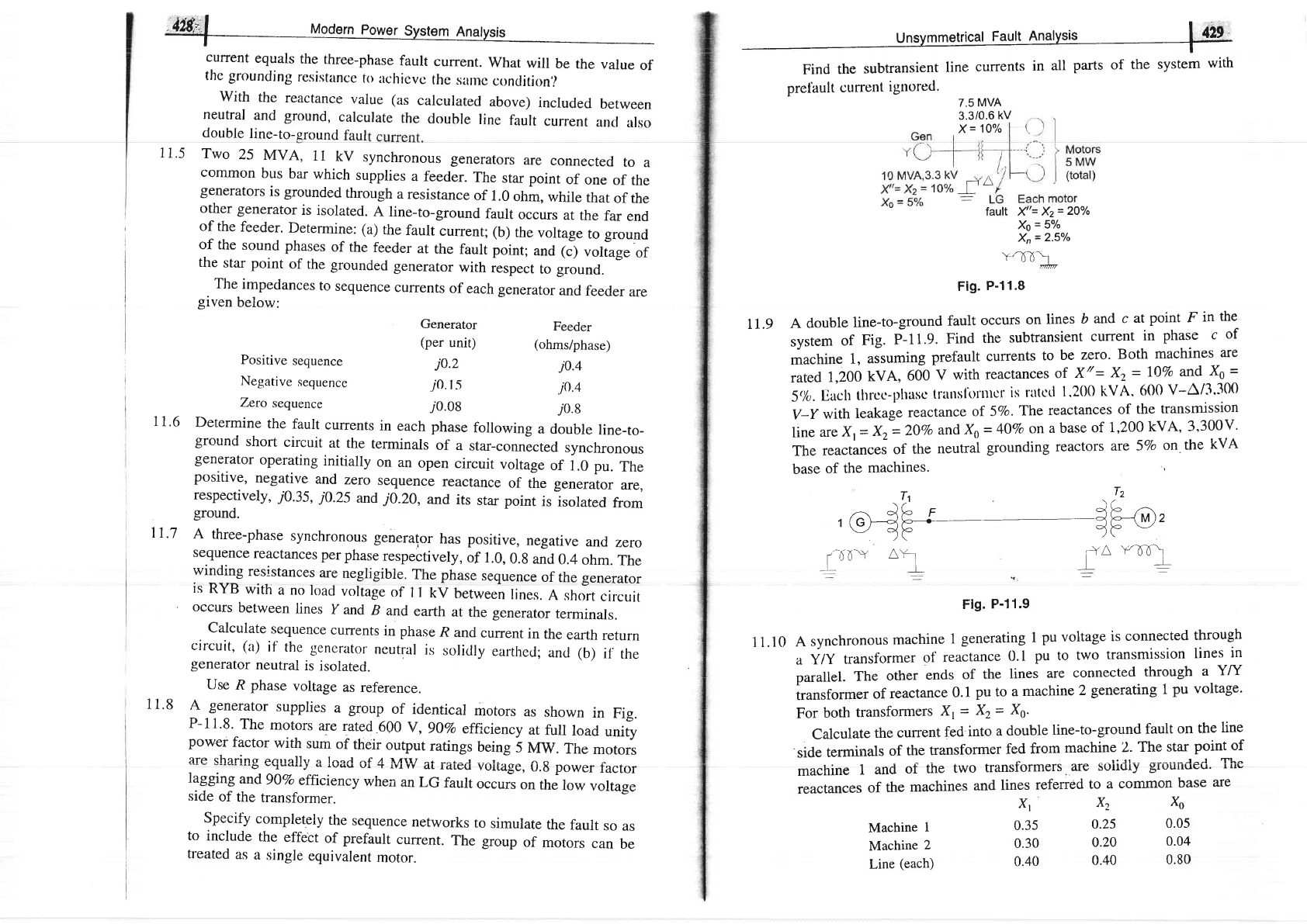
11'5
Two
25
MVA,
11
kv
synchronous
generators
are
connected
to
a
common
bus
bar
which
supplies
a
feeder.
The
star point
of
one
of
the
generators
is
grounded
through
a
resistance
of
1.0
ohm,
while
that
of the
other
generator
is
isolated.
A
line-to-ground
fault
occurs
at
the
far
end
of the
feeder.
Determine:
(a)
the
fault
current;
(b)
the
voltage
to
ground
of the
sound
phases
of
the
feeder
at
the
fault
point;
and
r.l
"orilg"
bi
the
star
point
of
the grounded
generator
with
iespect
to
ground.
The
impedances
to
sequence
currents
of
each
generator
and
feeder
are
given
below:
lW:il
Mqdern
power
Syst€m
Anatysis
current
equals
the
three-phase
fault
current.
What
will
be
the
value
of
the
grounding
resistance
to
achicvc
thc samc
conclition,l
with
the
reactance
value (as
calculated
above)
included
between
neutral
and ground,
calculate
the
double
line
fault
current
ancl
rlso
double
line-to-ground
faul
t*t.
sub-^
prelault
current
ignored.
7.5
MVA
3.3/0,6
kv
X
=
10o/o
fauft X'=
Xz=
2oo/o
Xo
=
5o/o
Xn
=
2'5o/o
Yr6i*
Fig.
P-l1.8
n.g
A
double
line-to-ground
fault
occurs
on
lines
b
and
c
at
point F
in
the
system
of
Fig.
i-tf.q.
Find
the
subffansient
current
in
phase
c
of
machine
1,
assuming
prefault
currents
to
be
zero.
Both
machines
are
rated
7,200
kvA,600
v
with
reactances
of
x//=
xz=lUvo
and
xo=
5%.
llac5
thrcc-phirsc
trtnslorutcr
is
rutcd
1.200
kVA.
600
V-A/3.300
V-ts
with
leakage
reactance
of 5Vo.
The
reactances
of
the
transmission
line
are
X,=X,-=20vo
andXo=
4oTo
on
a base
of
1,200
kVA,
3,300V'
The
reactances
of
the
neutral
grounding
reactors
are
5Vo
on
the
kVA
base
of
the
machines.
Positive
sequence
Negative
sequence
Zero
sequence
Generator
(per
unit)
jo.2
i0.15
j0.08
Feeder
(ohms/phase)
j0.4
j0.4
j0.8
rI'6
Determine
the
fault
currents
in
each
phase
following
a
double
line-to-
ground
short
circuit
at
the
terminals
of
a
star-connected
synchronous
generator
operating
initially
on
an
open
circuit
voltage
or
i.o
pu.
The
positive,
negative
and
zero
sequence
reactance
of
the generator
are,
respectively,
70.35,
j0.25
and
j0.20,
and
its
star point
is
isolated
from
ground.
11'7
A
three-phase
synchronous
generator
has
positive,
negative
and
zero
sequence
reactances
per
phase
respectively,
of
1.0,
0.g
and
0.4
ohm.
The
winding
resistances
are
negligible.
The phase
sequence
of
the generator
is
RYB
with
a no
load
voltage
of
I I
kV
between
lines.
A
short
circuit
occurs
between
lines
I and
B
and
earth
at
the generator
terminals.
Calculate
sequence
currents
in
phase
R
and
current
in
the
earth
return
circuit, (a)
if
the
gencrator
neutral
is
solidly
earthecl;
ancl
(b)
il
the
generator
neutral
is
isolated.
Use
R
phase
voltage
as
reference.
11.8
A
generator
supplies
a
group
of
identical
motors
as
shown
in
Fig.
P-11'8.
The
motors
are
rated
600
V,
9O%o
efficiency
at
full
load
unity
power
factor
with
sum
of
their
output
ratings
being
i
rrrrW.
The
motors
afe sharino enrrqllrr o l^o.l ^€./t l\trrr ^t -^.^r ---'.
s
rvsu
\^'r
lvrvv
ilr
laL€u
v'r'age,
u.6 power
tactor
lagging
and
90vo
efficiency
whea
an
LG
fault
occurs
on
the
low
voltage
side
of
the
transformer.
Specify
completely
the
sequence
networks
to
simulate
the
fault
so
as
to
include
the
effect
of
prefault
current.
The
group
of
motors
can
be
treated
as
a
single
equivalent
motor.
_r_rr*
"1_
xl
0.35
Xz
xo
0.25
0.30
0.20
0.05
0.04
0.80
i^
vn6l
,_L
-:
Flg.
P'11.9
1 1.10
A
synchronous
machine
1
generating
1
pu voltage
is
connected
through
a
Y/Y
transformer
of
reactance
0.1
pu to
two
transmission
lines
in
parallel.
The
other
ends
of
the
lines
are
connected
through
a
YN
transformer
of
reactance
0.1
pu
to
a
machine
2
generating
1
pu voltage'
For
both
transformers
X,
=
Xz
=
Xo'
Calculate
the
current
fed
into
a
double
line-to-ground
fault
on
the
line
'side
terminals
of
the
transformer
fed
from
machine
'2.
The
star
point
of
machine
I
and
of
the
two
transiormers.
are
soiiriiy
grourrded.
The
reactances
of
the
machines
and
lines
referred
to
a common
base
are
Machine
1
Machine
2
Line
(each)
0.40
0.40
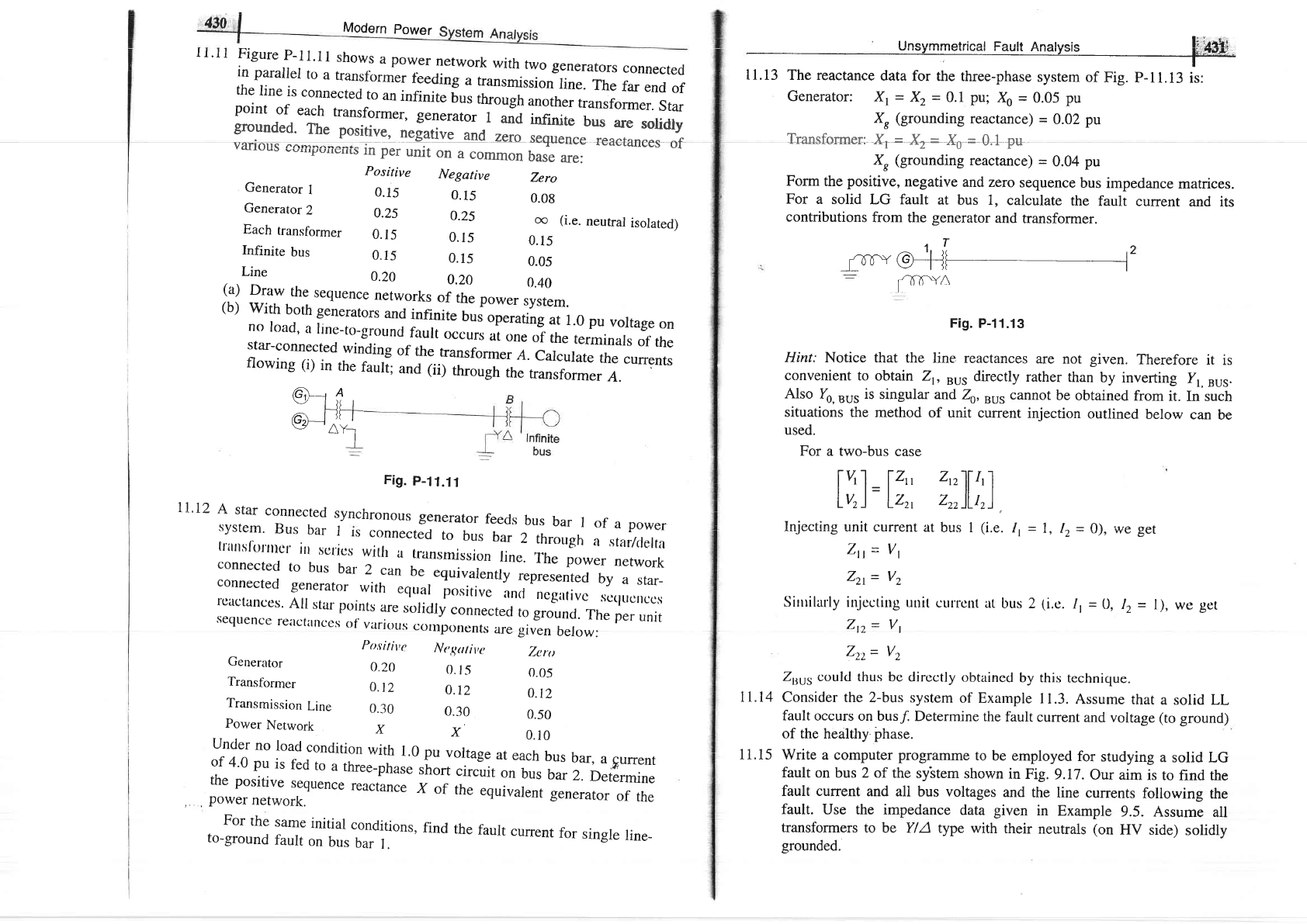
Modern
power
ll'll
iltr"::,i"il"ti .1T:-Toow.er
nerwork
with
two
generators
connecred
il"lili 1:'
"
: : i::, {:,il.: f:
"
9,,.*
;
;il;;
;
;".il:i
i.H
flffi
,:i
:T
"tl'
:
j.
"."11'::::1.r:
un
i
n
ri
ni
te
fr
u
s
il;
*''
;ffi
#
Hffi
ff
#,f
i,:il".5.T1",ffi,1,iJl.:^::l:l;,-i""i;ffi*"#,J'#::,irfr
fl:f{",,":t'
The
pot+-:
q"geEye
uno
zero
seque;r1:#;:"#
viltr'om
vv'rv\,rerr,-"
in
pEr
fiit
*:"
""*"t-;;;il#,
Positive
Negative
Zero
Generator
I
0.15
0.15
0.0g
Generaror
2
0.25
0.25
oo
(i.e.
neutral
isolated)
Each
rransformer
0.15
0.15
0.15
Infinite
bus
0.15
0.15
0.05
Line
0.20
0.20
0.40
l.] P_-....*,the
sequence
networks
of
the
power
;;_
(b)
with
borh
generarors
and
infinite
bus
op"rutinf
"a
r.o
pu
voltage
on
no
road,
a
rine-to-grouncr
faurt
occurs
at
.ne
of
the
terminars
of
the
star-connected
winding
of
the
transformer
A.
caiculate
the
currents
flowing
(i)
in
the
fauli;
and (ii)
through
rhe
transformer
A.
6L-_'
,q
\--7
| )r I
I_ ]L
I
,
-xlJ|l
Itz2,H
"..'
/\ Y-
-_t
Fig.
p-11.11
rl'r2
A
star
connected
synchronous
generator
feeds
bus
bar
r
of
a
power
system.
Bus
bar
I
rs
connected
to
bus
bar
2
thro'gh
a
star/crerta
lt'itnsl0t'ttlcl'
ilt
scrics
with
a
transmission
line.
The
power
network
connected
to
bus
bar
2
can
be,
"quiuutently'
represented
by
a
star_
connected
generator
with
equar
positive
incr
ncg.tivc
sc(rr.r0rccs
rcactances.
Alr
star
pornts
are
solidry
connected
to
ground.
The
per
unit
sequence
re:lct*nces
of
v'rious
corrlponents
are
given
berow:
pol;itive
Nc,,gutivt:
Zt:ro
Generator
0.20
0.l5
0.05
Transfbrmer
OJZ
0.12
0.12
Transmission
Line
0.30
0.30
0.50
PowerNerwork
X
X
0.10
Under
no
load
condition
with
1.0
go
voltage
at
each
bus
bar,
a
current
of
4'0
pu
is
fed
to
a
three-phase
short
circ-uit
on
bus
bar
Z.Deitrmhe
the
positive
sequence
reactance
X
of
the
equivarent
generator
of
the
,, .
power
network.
For
the
same
initial
conditions,
find
the
faurt
current
for
single
line_
to-ground
fault
on
bus
bar
l.
'
I lncrrrnmatrinal Farrlt Anahraio lL.'A+\l
Generator:
Xr
=
Xz
=
0.1
pui
Xo
=
0.05
pu
X,
(Brounding
reactance)
=
0.02
pu
Transformer:
Xr:
Xr:Xt
=
0J?u
X,
(grounding
reactance)
=
0.04
pu
Form
the
positive,
negative
and zero
sequence
bus
impedance
matrices.
For
a solid
LG fault
at
bus 1,
calculate
the
fault
current
and its
contributions
from
the
generator
and
ffansformer.
1,L2
_f6l-Y
€fff
rTft-YA
Fig.
P-11.13
Hint:
Notice
that the
line reactances
are
not
given.
Therefore
it
is
convenient
to obtain
Zt,
svs
directly
rather
than
by
inverting
Ir,
sus.
Also
ro,
"us
it
singular
and zs,
BUS
cannot
be
obtained
from
it.
In such
situations
the method
of unit
current
injection
outlined
below
can
be
used.
For
a two-bus
case
Injecting
unit current
at
bus 1
(i.e.
Ir
=
tr, !2=
0),
we
get
Zn=
Vt
Zzt
=
Vz
Sirnilarly
injccting
rruit
currcut
ut
bus 2
1i.c.
/r
=
0, lz
=
l), we
get
Ztz
=
Vl
7:tz
=
Vz
Zou5
could thus
bc dircctly
obtained
by this
technique.
ll.l4
Consider the
2-bus system
of
Example
11.3.
Assume
that
a solid LL
fault
occurs on busf
Determine
the
fault
current
and
voltage
(to
ground)
of the
healtlry
phase.
11.15
Write
a computer
programme
to
be employed
for
studying
a
solid LG
fault
on bus 2 of
the
sy'stem
shown
in Fig.
9.17.
our aim
is
to
find
the
fault current
and
all bus voltages
and
the
line currents
following
the
fault.
use the
impedance
data given
in
Example
9.5. Assume
all
transformers
to be YlA
type with
their
neutrals
(on
HV
side)
solidly
grounded.
li;,1=17,',7,',)l';,1
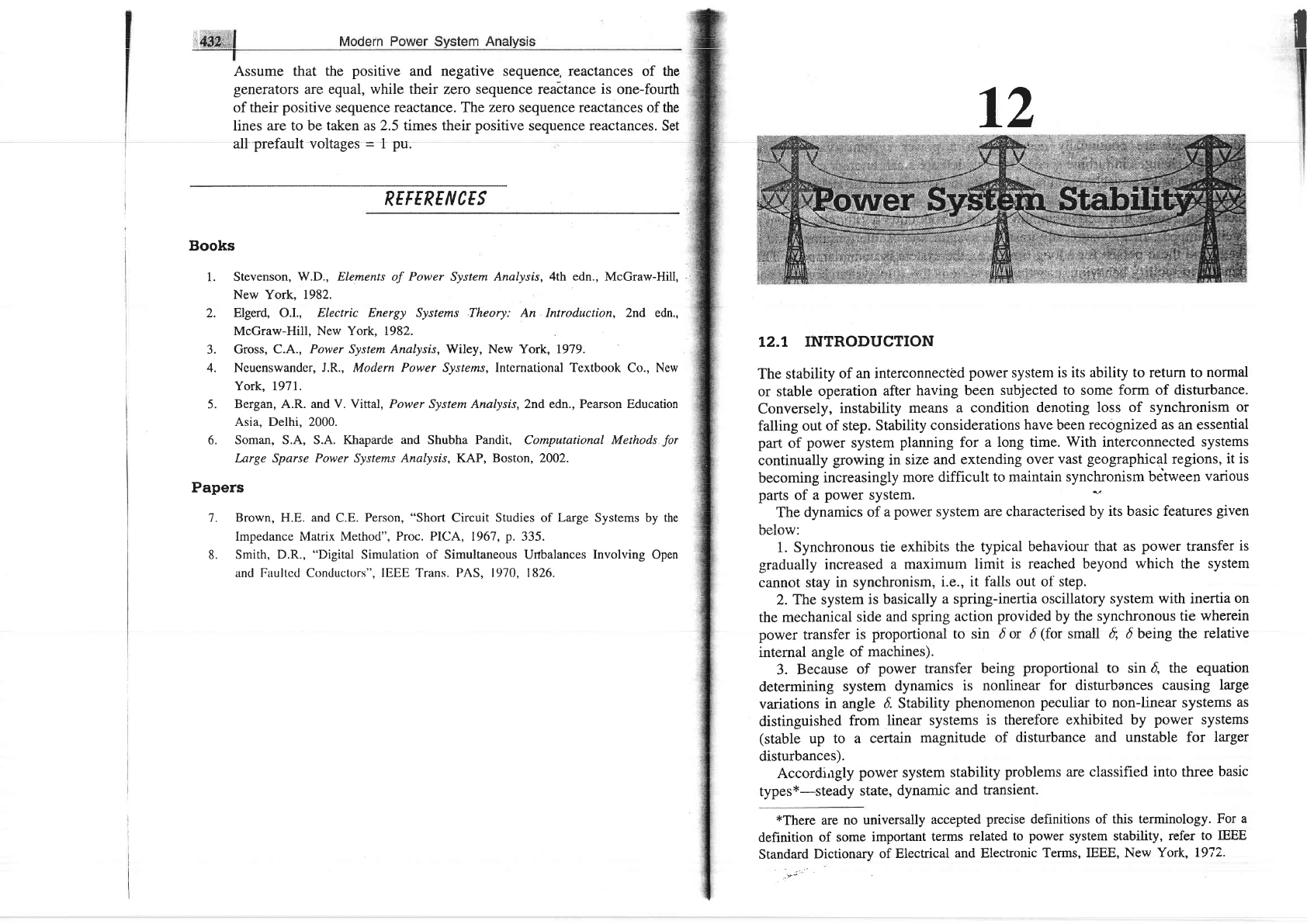
Assume that
the
positive
and
negative
sequence, reactances
of the
generators
are equal,
while their
zero sequence reactance
is
one-fourth
of their
positive
sequence reactance. The
zero
sequence reactances of the
lines are to be
taken as 2.5 times their
positive
sequence
reactances.
Set
all
prefault
voltages
=
1
pu.
REFERE
N
CES
Books
1. Stevenson,
W.D., Elements of Power
System
Analysis,4th edn., McGraw-Hill,
New York, 1982.
2.
Elgerd, O.I., Electric Energy Systems Theory: An Introduction, 2nd edn.,
McGraw-Hill, New York, 1982.
3.
Gross, C.A.,
Power
System
Analysis, Wiley, New York, 1979.
4. Ncuenswander,
J.R., Modern Power
Systems, International Textbook Co., Ncw
York, 1971.
5.
Bergan, A.R. and V. Vittal, Power System Analysis,2nd edn., Pearson Education
Asia, Delhi, 2000.
6. Soman, S.A, S.A.
Khaparde and
Shubha
Pandit,
Computational
Methods
for
Large Sparse Power Systems
Analysis,
KAP,
Boston,
2002.
Papers
7.
Brown, H.E.
and
C.E.
Person,
"Short
Circuit Studies of Large Systems by the
Impedance Matrix Method",
Proc. PICA,
1967,
p.
335.
8.
Smith,
D.R.,
"Digital
Simulation
of
Simultaneous Urrbalances
Involving
Open
and Faultcd Conductors",
IEEE Trans. PnS, 1970, 1826.
12
T2.T
INTRODUCTION
The stability
of
an interconnected
power
system
is its ability to return to
normal
or stable
operation
after
having been
subjected to some
form of disturbance.
Conversely,
instability
means
a
condition
denoting
loss of synchronism
or
falling
out of step.
Stability
considerations
have been
recognized as an essential
part
of
power
system
planning
for
a long time.
With
interconnected
systems
continually
growing
in size
and extending
over
vast
geographical
regions,
it is
becoming
increasingly
more difficult
to maintain
synchrortism bdtween
various
parts
of a
power
system.
'.
The
dynamics
of
a
power
system
are characterised
by its basic features
given
tjElt w.
1.
Synchronous
tie exhibits
the typical behaviour
that as
power
transfer
is
gradually
increased
a maximum
limit
is reached beyond
which
the
system
cannot stay
in synchronism,
i.e., it
falls out of step.
2.
The system
is
basically
a spring-inertia
oscillatory system
with
inertia
on
the mechanical
side
and spring
action
provided
by the synchronous
tie
wherein
power
transfer
is
proportional
to sin d or d
(for
small
E, 6 being the
relative
internal angle
of
machines).
3.
Because
of
power
transfer
being
proportional
to sin d,
the equation
determining
system
dynamics
is
nonlinear for
disturbances causing
large
variations
in angle
d, Stability
phenomenon
peculiar
to non-linear systems
as
distinguished
from
linear systems
is
therefore
exhibited by
power
systems
(stable
up
to a certain
magnitude
of disturbance
and unstable for
larger
disturbances).
Accordi^rgly
power
system
stability
problems are classified into three
basic
types*-steady
state,
dynamic
and transient.
*There
are
no universally
accepted
precise
definitions of this
terminology.
For a
definition
of some
important
tenns
related
to
power
system stability,
refer to
IEEE
Standard
Dictionary
of
Electrical
and
Electronic
Terms,
IEEE, New
York, 19i2.
il
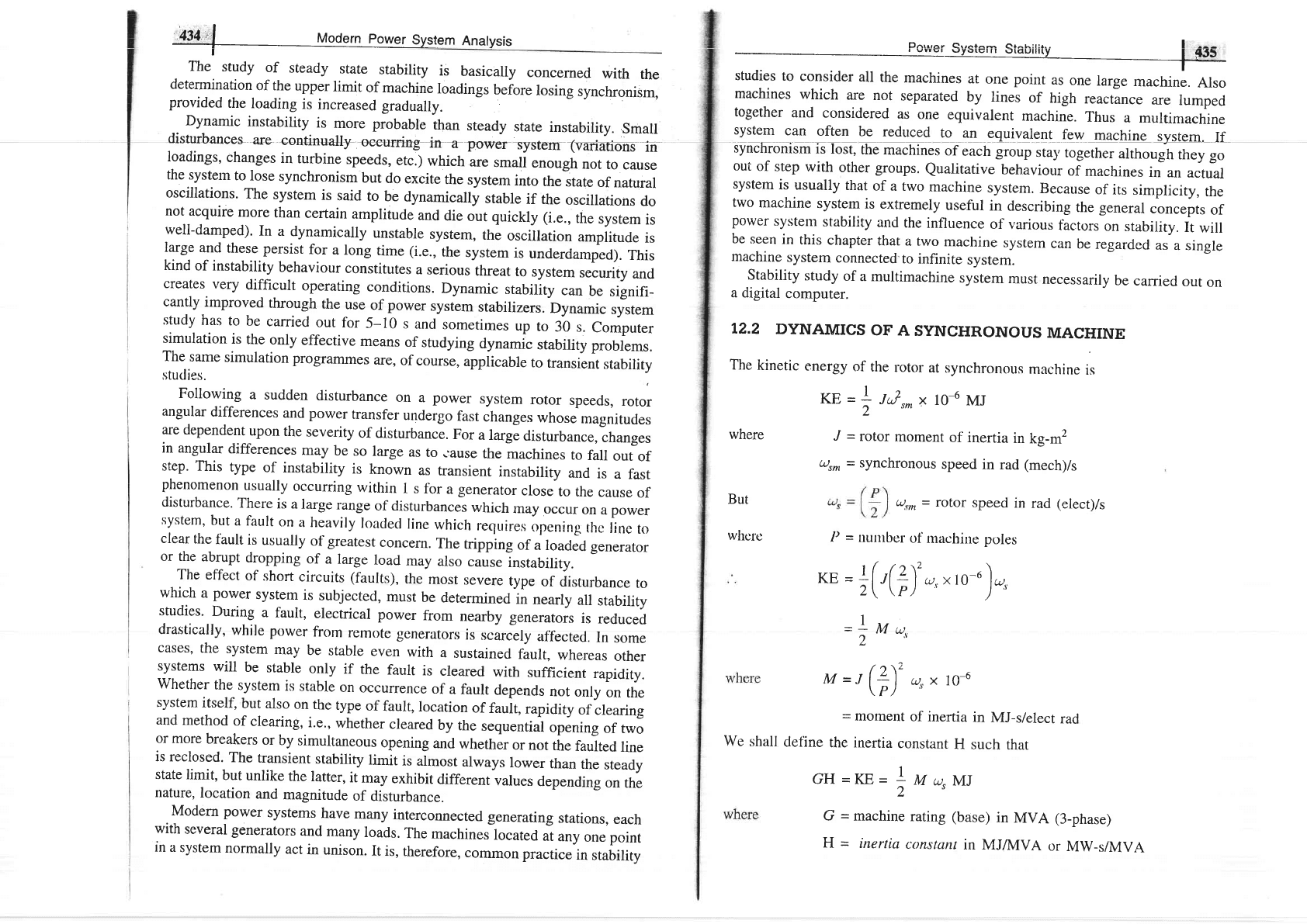
'l
434
.'l
Modern
power
System
Analysis
Th"t
study
of
steady
state
stability
is
basically
concerned
with
the
determination
of
the
upper
limit
of
machine
loadings
beiore
losing
synchronism,
provided
the
loading
is
increased
gradually.
Dynamic
instability
is
more
probable
than
steady
state
instability.
Small
disturbances
are
esntinuaHy
oeeurring
irr
a
po*..
system
r"#"ti"*
i"
loadings,
changes
in
turbine
speeds,
etc.)
which
are
small
enough
not
to
cause
the system
to
lose
synchronism
but
do
excite
the
system
into
the"itate
of
natural
oscillations.
The
system
is
said
to
be
dynamically
stable
if the
oscillations
do
not acquire
more
than
certain
amplitude
and
die
out quickly
(i.e.,
the
system
is
well-damped).
In
a
dynamically
unstable
system,
the
oscillation
amplitude
is
large
and
these
persist
for
a long
time
(i.e.,
the
system
is
underda-p"a;.
rni,
kind
of instability
behaviour
constitutes
a serious
threat
to
system
security
and
creates
very
difficult
operating
conditions.
Dynamic
stability
can
be
signifi-
cantly
improved
through
the
use
of
power
system
stabilizers.
Dynamic
system
study
has
to
be
carried
out
for
5-10
s
and
sometimes
up
to
30
s.
computer
simulation
is
the
only
effective
means
of
studying
dynamic
stability
problems.
The
same
simulation
programmes
are,
of
course,
appiicable
to
transient
stability
studies.
Following
a
sudden
disturbance
on
a
power
system
rotor
speeds,
rotor
angular
differences
and power
transfer
undergo
fast
changes
whose
magnitudes
are
dependent
upon
the
severity
of disturbance.
For
a large
disturbanc",
"hung..
in angular
differences
may
be
so
large
as
to
.:ause
the
machines
to
fall
out
of
step' This
type
of
instability
is
known
as
transient
instability
and
is
a
fast
phenomenon
usually
occurring
within
I
s fbr
a
generator
close
to
the
cause
of
disturbance.
There
is
a large
range
of disturbancei
which
may
occur
on
a
power
system,
but
a fault
on
a heavily
loaclecl
line
which
requires
opening
thc
lipc
t<l
clear
the
fault
is usually
of greatest
concern.
The
tripping
of
a loadJd
generator
or the
abrupt
dropping
of
a large
load
may
also
cause
instability.
The
effect
of short
circuits (faults),
the
most
severe
type
of
disturbance
to
which
a
power
system
is
subjected,
must
be
determined
in
nearly
all
stability
studies'
During
a fault,
electrical
power
from
nearby
generators
is
reduced
drastically,
while
power
from
remote
generators
is
scarcely
af1'ecte4.
ln
some
cases'
the
system
may
be
stable
even
with
a
sustained
fault,
whereas
other
systems
will
be
stable
only
if
the
fault
is
cleared
with
sufficient
rapidity.
Whether
the
system
is
stable
on
occurrence
of
a fault
depends
not
only
on
the
system
itself,
but
also
on
the
type
of
fault,
location
of
fauit,
rapidity
of
clearing
and
method
of
clearing,
i.e.,
whether
cleared
by
the
sequential
opening
of
two
or
more
breakers
or
by
simultaneous
opening
and
whether
or
not
the
faulted
line
is reclosed.
The
transient
stability
limit
is
atmost
always
lower
than
the
steady
state limit,
but
unlike
the
latter,
it
may
exhibit
different
values
depending
on
the
nature,
location
and
magnitude
of
disturbance.
Modern
power
systems
have
many
interconnected
generating
stations,
each
with
several
generators
and
many
loads.
The
machineJlocated
a-t
any
one point
ln
a
system
normally
act
in
unison.
It is,
therefore,
common
practice
in
stability
Dnrrrn' Qrra+^- Or^L:l:r-. I -^-
machines
which
are
not
separated
by
lines
of
high
reactance
are
lumped
together
and
considered
as
one
equivalent
machine.
Thus
a
multimachine
system
can
often
be reduced
to
aq
equlyalg4t
fery
lq4qhrue
system-
If
Synchronlsm
ii lost,
ttre rn'achinei
of
eaitr gioup
stay
together
although
they
go
out
of
step
with
other
groups.
Qualitative
behaviour
of
machines
in an
actual
system
is
usually
that
of
a two
machine
system.
Because
of
its
simplicity,
the
two
machine
system
is
extremely
useful
in
describing
the
general
concepts
of
power
system
stability
and
the
influence
of
various
t'actors
on
stability.
It
will
be
seen
in
this
chapter
tbata
two
machine
system
can
be
regarded
as
a single
machine
system
connected.to
infinite
system.
Stability
study
of
a multimachine
system
must
necessarily
be
carried
out
on
a
digital
computer.
I2.2
DYNAMICS
OF
A
SYNCHRONOUS
MACHINE
The
kinetic
energy
of
the
rotor
at
synchronous
machine
is
JJ,^
x
10-6
MJ
where
But
whorc
We shall
-/
=
rotor
moment
of inertia
in
kg-m2
aro,
=
synchronous
speed
in
rad
(mech)/s
u.r,n
=
rotor
speed
in
rad (elect)/s
P
=
nuurbel
o1'rnaclrine
poles
=
moment
of inertia
in
MJ-s/elect
rad
detine
the inertia
constant
H
such
that
KE=1
2
M=J(?\'u,x10-6
\P/
',
GH=KE=
!u%MJ
2
KE
=
+(t(?)'c.,.
xro-.)*
-L
M,
2',
G
=
machine
rating (base)
in
MVA
(3-phase)
H
=
inertict
constant
in
MJ/I4VA
or
MW-s/MVA
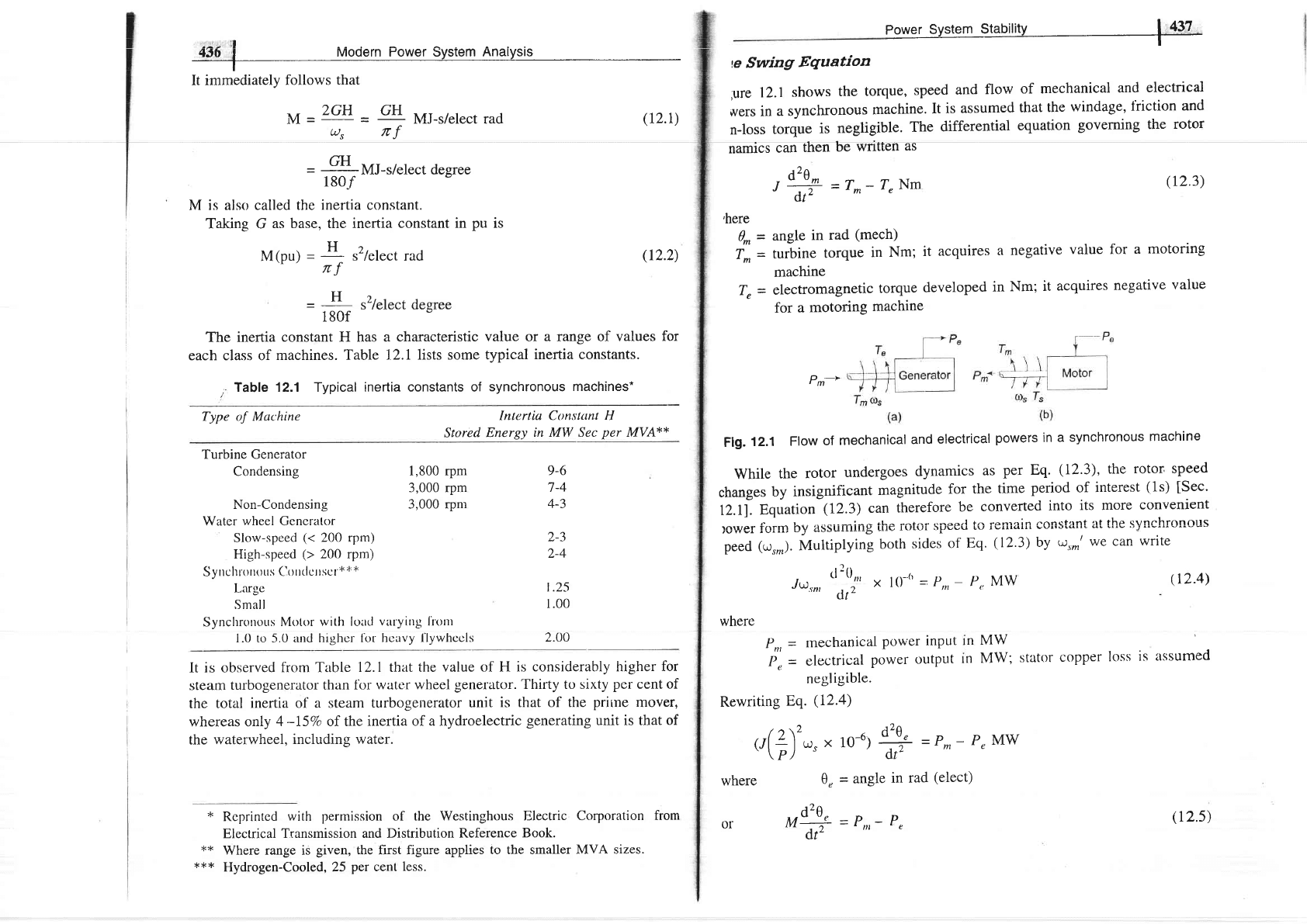
'.:
-:
il
{36
i
Mociern Power Sysiem
nnaiysis
I
It immediately
follows
that
M
=
2GH
=
GH
MJ-s/elect rad
(ts
lt
f
=
ffi
14J-s/elect degree
180-f
M
is also called the
inertia constant.
Taking G
as base, the inertia
constant in
pu
is
M
(pu)
=
+
s2lelect rad
nf
(r2.r)
(r2.2)
H ),,
=
ffi
s'lelect
degree
The inertia
constant H has a characteristic
value
or
a range of values
for
each class of
machines. Table
12.1 lists some typical
inertia constants.
,
Table 12.1 Typical
inertia constants of
synchronous
machines*
Type
oJ Mat:hine
Intertia Con.slunt H
Stored
Energy
in MW Sec
per
MVA**
Turbine Generator
Condensing
Non-Condensing
Water
wheel
Gencrzttor
Slow-speed
(<
200 rpm)
High-speed
(>
200 rpm)
Synchlorrous
Corrdcrrscr'+
+ 4
Large
Small
Synclrrcnous
Motor with
load
varying
li'ortr
1.0 to 5.0 and
highcr lor hcavy
l'lywhccls
It is observed
from Table
12.1 th'at the
value of H is
considerably higher
for
steam
turbogenerator thzrn
tbr watc:r
wheel
generator. Thirty to sixty
per
cent of
the
total inertia
of a steam
turbogenerator
unit
is that of the
priine
mover,
whereas only
4
-I5Vo
of the
inertia of a hydroelectric
generating
unit is that
of
the
waterwheel,
including water.
1,800 rpm
3,000 rpm
3,000 rpni
9-6
7-4
4-3
L-J
2-4
t.25
l.00
2.00
*
Rcprinted
with
permission
of the Westinghous
Electric Corporation
Electrical
Transmission and Distribution
Reference
Book.
+*
Where range is
given,
the first figure
applies to the smaller
MVA sizes.
*tc+
Hydrogen-Cooled,25
per
cent
less.
from
Power
System
Stability
I
437
I
e Swing
Equation
;ure
12.1
shows
the
torque,
speed
and
flow
of mechanical
and
electrical
wers
in
a synchronous
machine.
It
is assumed
that
the
windage,
triction
and
n-loss
torque
is
negligible.
The
differential
equation
governing
the
rotor
namics
can
then
be
written
as
-
d'o^
J
-:;t
=T^-
r"
Nt
ot-
'here
0*
T*
T,
=
angle
in
rad
(mech)
=
turbine
torque
in
Nm;
it
acquires
machine
=
electromagnetic
torque
developed
for
a
motoring
machine
o_>
tm
mechanical
ptlwer
inPut
electrical
power
outPttt
(r2.3)
a
negative
value for
a
motoring
in
Nm;
it
acquires
negative
value
Fig.
12.1
Flow
of
mechanical
and
electrical
powers in a
synchronous
machine
While
the
rotor
undergoes
dynamics
as
per Eq.
(12'3),
the
rotor' speed
changes
by
insignificant
magnitude
for
the
time
period of
interest
(1s)
[Sec.
0.i.
Equation
(12.3)
can
therefore
be
converted
into
its more
convenient
.
- L-.
.,..-,=*:**
r!:a *nr^r
('nerr.l
tn rcnrain cnnst:tnt
at thg SVnChfOnOUS
lnrltar Tnrm nv 2\\lllllllly lllc ltrltrl JUUUU Lv
lvllrqrtl
!vrrurqrrr
,vvrvr
tvrrlt
vJ
-
I
peed
(ur,.).
Multiplying
both
sides
of
Eq.
(
12.3)
by
u),,^'
we can
write
J6"n,
t':t);"
x lo-('
-
P^
P,.
Mw
dtt
where
MW
MW;
stator
copPer
(t2.4)
loss is
assumed
ln
tn
p
'ttt
-
D
t-,-
negligible.
Rewriting
Eq.
(12.4)
/ )\2
s2a
ul;)
u.r,
x
1o-6)
ff
-
P^
P,
Mw
where
0,
=
angle
in
rad
(elect)
nod'\, =,
-p
(12.5)
ol
Mi;-
=
P,,-
P"
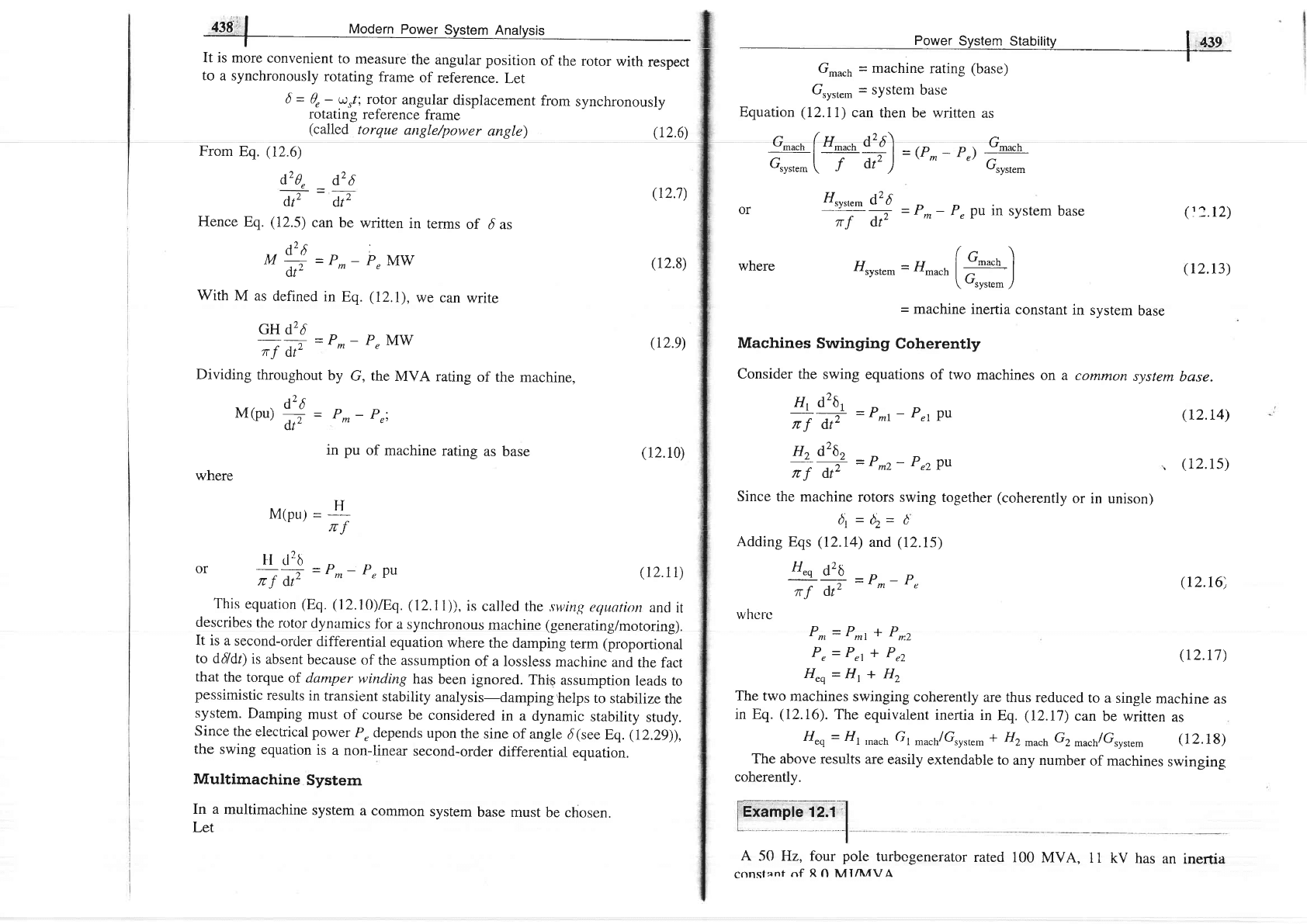
43S
I
Modern
power
Svstem
Analvsis
t
--
It is
more convenient
to
measure
the
angular
position
of
the
rotor with
respect
to
a synchronously
rotating
frame
of reference.
Let
o
=
(a;,?;['
;"':?:
f#
u l
ar
di s
P
1
ac e me
n t fro
m
s
y
n c hron
o u s l
y
(r2.6)
(r2.7)
(called
torque
angle/power
angle)
From
Eq.
(12.6)
drg,
_
d26
,Jt2
dt2
Hence
Eq.
(12.5)
can be
written
in
terms
of d as
,,
d26
'
M-:=P^-PeMw
ot-
With
M as
defined
in
Eq.
(12.1),
we can
write
GH
d2d
fV-P*-P"Mw
Dividing
throughoutby
G,
the
MVA rating
of the
machine,
a
M(pu)
+
=
P*-
P,;
dt'
in
pu
of machine
rating
as base
where
(12.8)
(r2.9)
(12.r0)
M(Pu)
=
+
lrj
H
dzb
or
^ -
=
P*-
P, pu
(IZ.1I)
nf
dt"
This
equation
(Eq.
(12.1D)l}q.(12.1
1)),
is
called the
stving
ecluatioy
and
it
describes
the
rotor
dynamics
fbr
a synchronous
machine
(generating/motoring).
It is
a second-order
differential
equation
where
the darnping
term
(proportional
to d6ldt)
is absent
because
of
the
assumption
of a lossless
machine
ancl
the fact
that
the
torque
of damper
winding
has been
ignored.
This
assumption
leads
to
pessimistic
results
in
transient
stability
analysis-dampinghelps
to
stabilize
the
system.
Damping
must
of
course
be
considered
in a
dynamic
stability
study.
Since the
electrical
power
P, depends
upon
the
sine
of angle
d(see
Eq.
(12.29)),
the
swing equation
is
a non-linear
second-order
differential
equation.
Multimachine
System
In a
multimachine
system
a common
system
base
must
be chosen.
Let
_
Power
System
Stabitity
_ I
+Sl
-
Grnu"h
=
machine
rating
(base)
Gryrt",o
=
system
base
Equation
(12.11)
can then
be
written
as
+-"
(Yry*l
=
(p-
-
p.)
g'""
Gsystem
\-
/
dt'
)
\
"t
c'
Grrr,.*
=
machine
inertia
constant
in system
base
Machines
Swinging
Coherently
Consider
the swing
equations
of two
machines
or
a common
system
base.
or
{"""'
o'!
='
-P
"f
dl
=
P*-
P"PU in
sYstem
base
where
Hryr,"*
=
H-u"h
t'+*l
**"
\..
Gt""'n
/
Hr d261
"f
a;
=
P*r
-
P"t
Pu
H2
d262
"f
A;
=
P*2-
P"zPu
Since
the machine
rotors
swing together
(coherently
or
in unison)
6,
=
[r=
[
Adding
Eqs
(12.14)
and
(12.15)
H"q
d26
trf
dtz
=
P*- P"
whcrc
Prr=P*r+
Pn
Pr=P"l *
Prz
H"q=Hr+
H,
ffimel"L2rl
1
(t:.r2)
(r2.r3)
(r2.14)
.
(12.rs)
(r2.16"
(r2.r7)
The two
machines
swinging
coherently
are
thus
reduced
to a
single
machine
as
in Eq.
(12.16).
The
equivalent
inertia
in
Eq.
(12.17)
can
be wrirten
as
H"q,
=
Hl
,nu.h
Gl
^ach/Grystem
*
Hz
^u"h
G2
-u"h/G.yr,..
(12.18)
The above results
are
easily
extendable
to
any number
of
machines
swinging
coherently.
A 50 Hz, four pole
turbogenerator
rated
100
MVA,
11
kv
has
an
inertia
g6nsf
anf
nf R
O MI/I\/IVA
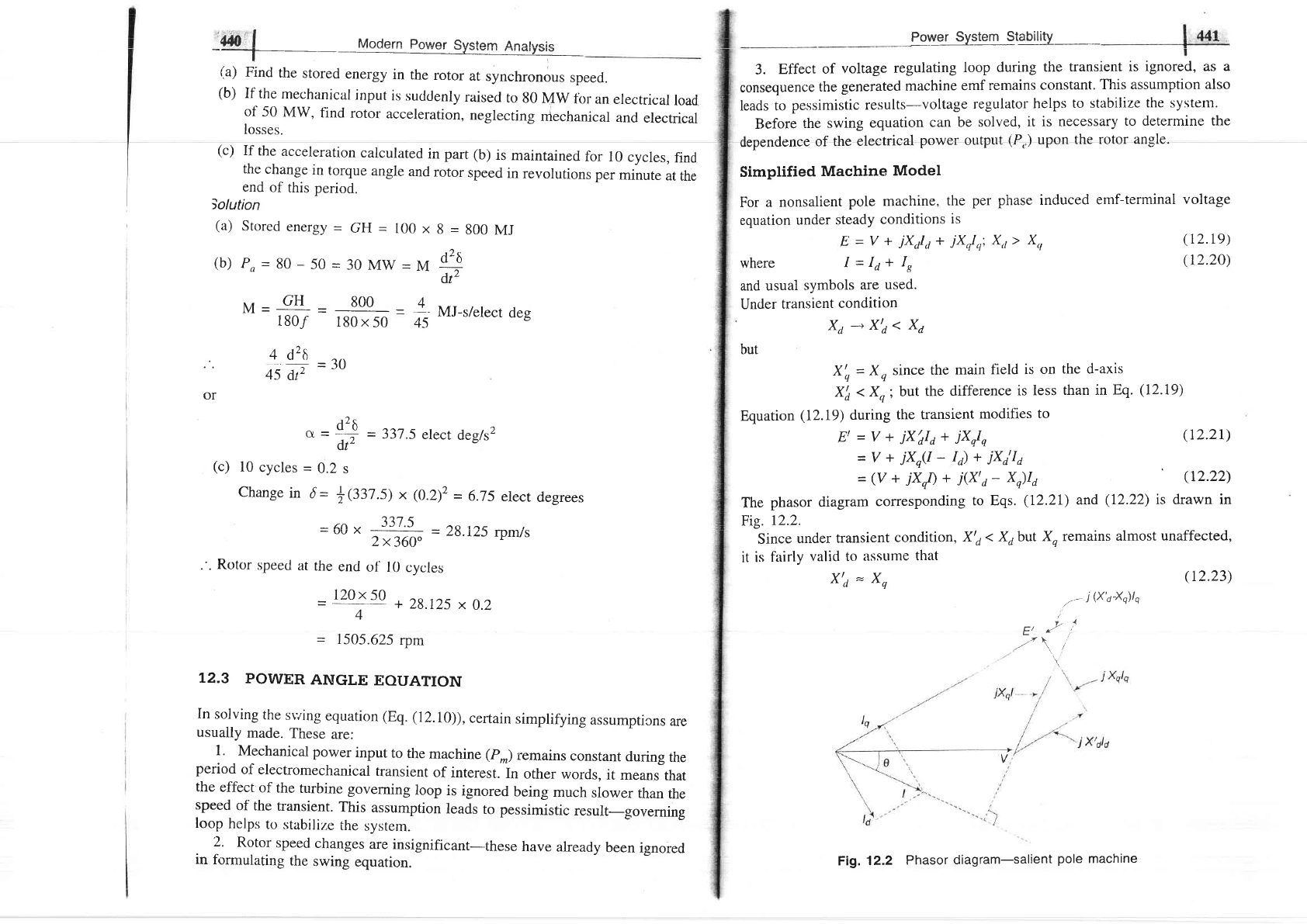
Find
the
stored
energy
in
the
rotor
at
synchronous
speed.
If
the
mechanical
input
is
suclcJenly
raised
to
80
MW
fbr
an
electrical
load
of
50
MW,
tind
rotor
acceleration,
neglecting
rrlechanical
and
electrical
losses.
(c)
If
the
acceleration
calculated
in part (b)
is
maintained
for
10
cycles,
find
the
change
in
torque
angle
and
rotor
speed
in
revolutions
per
minute
at
the
end
of
this period.
)olution
(a)
Stored
energy
=
GH
=
100
x
g
=
g00
MJ
(b)
P,=80-50=30MW=M
4
dt'
r,
CH
800
.1
--
180/
180 x
50
4
d26
+'j
6,2
=
3o
or
r) c
(c)
10
cycres
=
"lT
-
337
'5
elect
deg/s2
Change
in
d=
!{ZZI.S)
x
(0.2)2
=
6.75
elect
degrees
=
60
x
337'5
.o 1^E !
2x360J
=
z6'12r
{PnVs
.'.
Rotor
speed
at
the
end
of
l0
cvcles
-
r2ox5o
+'z8.tz5
x
0.2
4
=
1505.625
rpm
I2.3
POWER
ANGLE
EQUATION
In
solving
the
s'uving
equation (Eq
(12.10)),certain
simplifying
assumpticns
are
usually
made.
These
are:
1.
Mechanical
power
input
to
the
machine (P*)
remains
constant
during
the
period
of electromechanical
transient
of
interest.
In
other
words,
it
means
that
the
effect
of
the turbine
governing
loop
is
ignored
being
much
slower
than
the
speed
of
the
transient.
This
assumption
leads
to pessimistic
result-governing
loop
helps
to
stabilize
the
sysrem.
'2.
Rotor
speed
changes
are
insignificant-these
have
already
been
ignored
in
formulating
the
swing
equation.
(a)
(b)
t4/s'
I torJern Power Srrctarn Anarrraio
--
4
MJ-r/elect
deg
teryer-Svele
m-qtsqllv--
3.
Effect
of
voltage
regulating
loop
during
the
transient
is ignored, as a
consequence
the
generated
machine
emf
remains
constant.
This
assumption
also
leads
to
pessimistic
results-voltage
regulator
helps
to stabilize
the system.
Before
the swing
equation
can be
solved,
it
is necessary
to determine the
dependence
of the
electrical
powel otttput
(P,,)
upon
the rotor
angle.
Simplified
Machine
Model
For
a nonsalient
pole machine,
the
per
phase induced
emf-terminal
voltage
equation
under
steady
conditions
is
where
E
=V
+
jXolu+
jXol,,;
X,r)
X,r
I=Ia+
Is
(r2.Ie)
(r2.20)
(12.2r)
'
(12.22)
and usual
symbols
are
used.
Under
transient
condition
Xa
-X'a1Xa
but
X'o
=
Xn
since
the
main
fleld is
on
the
d-axis
Xtd
< Xo
;
but
the
difference
is
less
than in
Eq'
(I2.I9)
Equation
(12.19)
during
the
transient
modifies
to
Et
=V
+
jxtlo+
jXnln
=V
+
jXq(I
-
I) +
jXotlo
=
(Y
+
jxp
+
j(X'a
-
Xq)Id
The
phasor
diagram
colresponding
to Eql
(12.21)
and
(12.22)
is
drawn
in
Fig.
12.2.
Since
under
transient
condition,
X'a
1X, but
Xn remains
almost unaffected,
it
is
fairly
valid to
assttme
that
x'a
=
xq
(r2.23)
Fig.
12.2
Phasor
diagram-salient
pole
machine
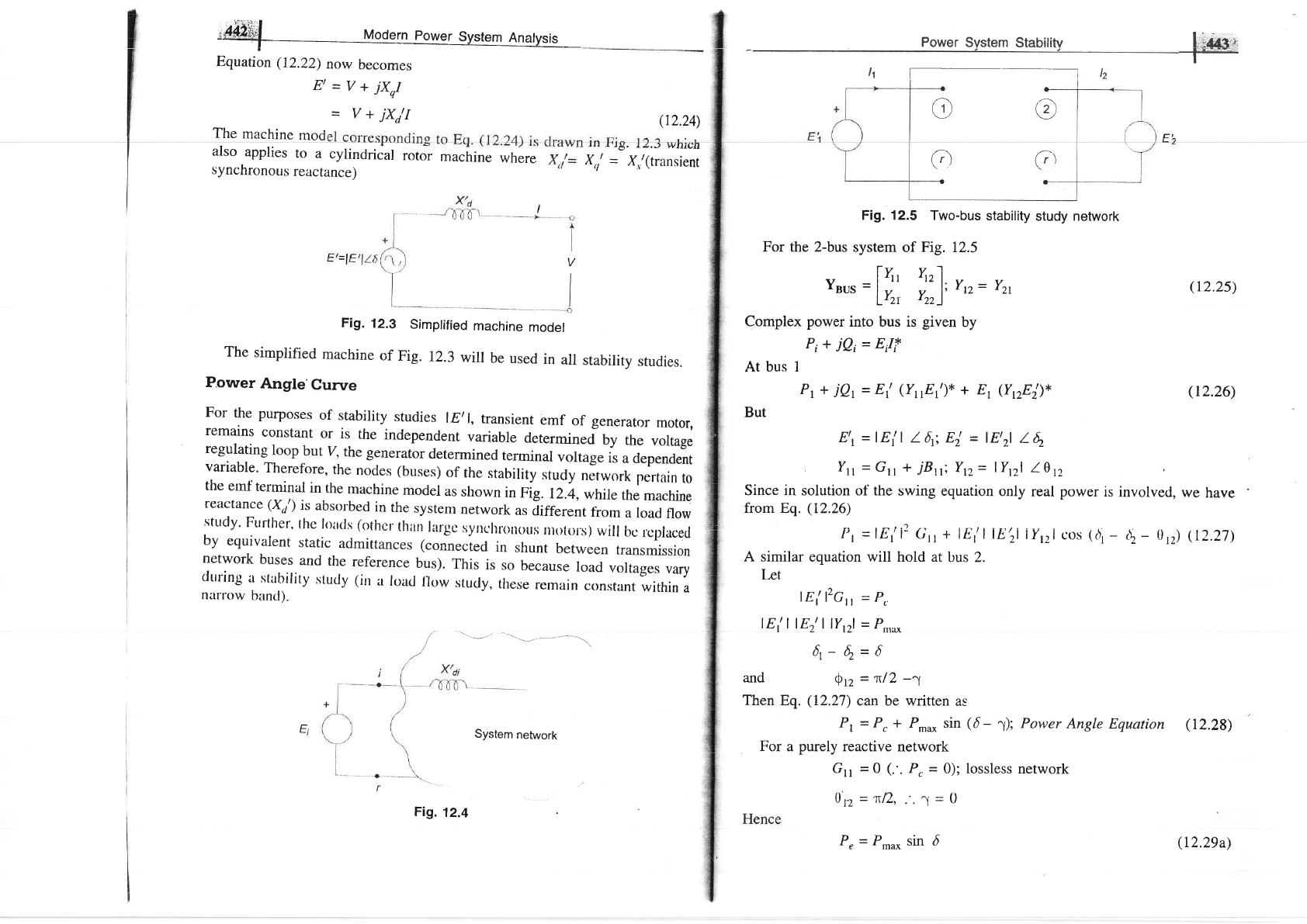
,firZlll
r"orrr
r
atysis
_
equation
(12.22)now
becomes
E,=V+jXnI
=
V +
jXotl
(r2.24)
The
machine
mod
also
applies
to
a
cylindrical
rotor
machine
where
---
- -D'
X,l
=
X*/(transient
synchronous
reactance)
The
simplified
machine
of
Fig.
12.3
will
be
used
in
all
stabilitv
studies.
P.ower
Angle'Cunre
For
the purposes
of
stability
studies
lEl1,
transient
emf
of generator
motor,
remains
constant
or
is
the
independent
variable
determined
by
the
voltage
regulating
loop
but
v,
the
generator
determined
terminal
voltage
is
a
dependent
variable'
Therefore,
the
nodes
(buses)
of
the
stability
study
network
pertain
to
the
ernf
terminal
in
the
machine
model
as
shown
in
rig.
12.4,
while
the
machine
reactance
(Xu)
is
absorbed
in
the
system
network
as
clifferent
from
a
load
flow
sttlcly'
Fttrther,
lhe loirtls
(othcr
thrrn
liu'gc
s;ynchronous
riitittir.s)
will
bc
r.cpiacetl
by
equivalent
static
admittances
(connected
in
shunt
between
transmission
network
buses
and
the
reference
bus).
This
is
so
because
load
voltages
vary
cltlring
a stability
stutly
(in
a
loacl
llow
stucly,
the.se
remain
constant
within
a
nalrow
bancl).
,/
System
network
Fig.
12.3
Simplified
machine
model
Fig. 12.5
Two-bus
stability
study network
For the 2-bus
system
of
Fig.
12.5
f
Y,,
Y"1
Ynus
=
I -j' -:' l;
Y,z=
Yzr
LY^
Yr,[
I
Complex
power
into
bus
is
given
by
Pi+
jQi-Elf
At bus I
Pr +
jQr
-
Er'
(YyE1)*
+ E,
(YpEil*
But
(r2.2s)
(r2.26)
E't
=lEil
l6; E/
=
lE'zl
14.
Y,u
=
Gr
t
+
jBti
Yrz
=
lYrzl
l0
p
Since in solution of the
swing equation
only
real
power
is
involved,
we
have
from
Eq.
(12.26)
Irt
=lEli2
Gtr+
lErt I iEii
iy,rl
cos
(,ti
-
,h
-
0,2)
u2.27)
A similar
equation
will
hold at
bus 2.
Let
lEllzG,
=
P,
lEt'l
lEzt I lY7l
=
Pn,*
4- 6=6
and
Qn
=
x/2
-1
Then Eq.
(12.27)
can be written
as
Pr
=
P,
* P,n"*
sin
(6
-
1);
Power Angle
Equation
(IZ.ZB)
For a
purely
reactive
network
Gtt
=
0
(.'.
P.
=
0); lossless
network
}tz=n12,
:.
J
=
0
P,=P^*sin
6
Power
Svstem
Stabilitv
[ECAC,+'
T*
\t2
o@
Ofr
Fig.
12.4
(12.29a)
